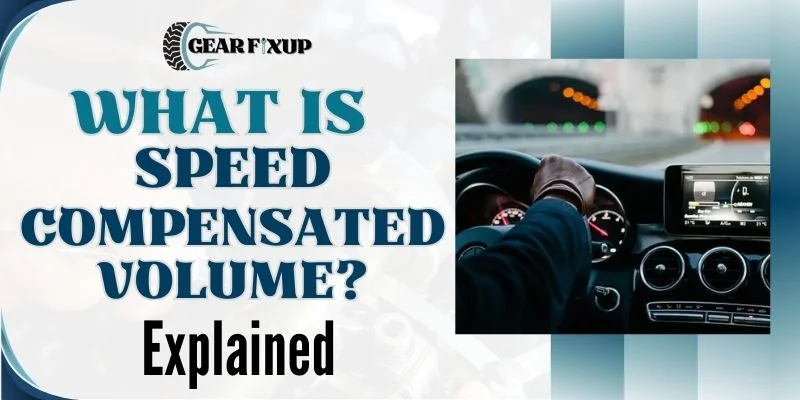It is a fun leisure activity to listen to your favorite songs while you are taking a long drive. Wind noise and road rash may negatively affect the experience if you’re driving at high speeds.
Speed Compensated Volume is a modern feature that prevents distortion in sound while driving. Using this feature, you can reduce noise in your vehicle through the sound system.

This blog post will provide a more in-depth review of Speed Compensated Volume:
What Is Speed Compensated Volume?
You can adjust the volume of the media playing in your car with speed compensated volume by using the stereo’s speed sensor. In order to prevent distortion, it changes the sound output based on your vehicle’s speed.
The background noise in your vehicle increases as it moves faster. If this feature isn’t available, you’d have to manually increase your stereo’s volume. It may be necessary to reduce the volume on your vehicle when you drive at slow speeds.
You can turn off manual interference completely by using speed compensated volume on your stereo.
Why Does Speed Compensated Volume Work?
As the engine, wind, road, and other ambient sounds are detected by the speed compensated volume feature, it adjusts the volume accordingly. The device measures your stereo’s sound level and adjusts the volume accordingly after sensing noise.

The media from your stereo can be heard clearly through this process. There is an indicator button on the audio system’s interface for cars equipped with this feature. You can adjust all the audio levels automatically according to the speed of your car when the audio is turned on.
Comparing speed compensated volume with automatic sound leveling
In many ways, speed compensated volume and automatic sound leveling accomplish the same thing. It makes sure you can hear everything on your car’s stereo by maintaining the level of the audio track, making it louder or softer as needed.
Toyota cars come standard with an ASL-capable JBL infotainment system. To adjust the volume of the sound system according to the noise levels inside and outside the car, three microphones are used (two in the rear and one in the front).
Various Speed Compensated Volume settings – Low, Mild, and High
In cars, speed compensated volume can be set in three different ways. Here is a brief overview of each:
Depending on the surrounding noise, you can adjust the speed volume settings.
Step-by-Step Guide To Adjusting Speed Compensated Volume
It is possible to modify the sensitivity of the system by following these steps, even though the feature adjusts the volume of your car’s stereo automatically:
Resolving challenges
Hurdles due to technical issues
The implementation of SCV involves some technical challenges, such as integrating it seamlessly with existing audio systems and ensuring precision in speed detection. In spite of these obstacles, technology continues to improve, making performance more smooth.
Read more about What Does Cruise Main Mean In A Car? Explained
Preferences of the user
A challenging aspect of automation is balancing user preferences with automation. In order to enable easy switching between automated and manual control, drivers may prefer manual control interfaces.
Speed Compensated Volume – How To Disable It?
Following are the steps for turning off your car’s speed compensated volume:
Not adjusting speed compensated volume?
There are two primary reasons why it may not work in your car – either you don’t have that particular feature, or the car won’t let you manually adjust it.

Alternatively, your car may have turned off the feature. It may be necessary to reactivate the feature in that case. Several reasons can result in non-adjustable speed control volume, including a malfunctioning volume speed control, or a bad BDR module.
It is necessary to perform a diagnosis of your ACM modules and identify the malfunctioning component in order to solve these issues. Afterwards, you’ll need a professional mechanic to reprogram or repair the particular function based on the issue.
Read more about What Does Depress A Brake Pedal Mean? Explained
Feature evolution
Future iterations of SCV will introduce additional features, which are still in the early stages of development. A more sophisticated audio adjustments algorithm as well as integration with other smart car features may be included.
You may read more about What Does The ASC System Service Required Light Mean?
Innovative ideas
SCV-related features will likely continue to advance as automotive audio technology advances. The latest advancements may include voice-activated controls, enhancing hands-free features and user-friendliness.
Benefits and drawbacks of speed compensated volume
An audio system that compensates for vehicle speed by automatically increasing or decreasing volume is known as speed compensated volume (SCV). With SCV, the volume level remains constant regardless of how fast the car is going.
SCV has the following benefits:
SCV has the following drawbacks:
A few tips for users
Benefits Maximization
The best way to maximize SCV is to regularly update the vehicle software and familiarize yourself with the customization options. An optimal audio experience can be achieved by taking these small steps.
Identifying and resolving common issues
It can be helpful to know how to troubleshoot common SCV issues in the event that there is a glitch or malfunction. The vehicle manual and checking for software updates are practical steps to troubleshoot a vehicle.
Read: What Does Full Accessory Power (FAP) Active Means In A Ford?
Read: What Does The Snow Button Do In A Toyota Highlander
Read: Ford F-150 Transmission Identification Codes Explained
Read: Low Washer Fluid Light Won’t Turn Off – Reasons & Fixes!
Frequently Asked Questions
Can I disengage Speed Compensated Volume for manual control?
You can disable SCV depending on your preferences in most vehicles.
Is Speed Compensated Volume effective in all weather conditions?
As a result of its design, SCV is capable of performing consistently in a variety of weather conditions.
Can Speed Compensated Volume be upgraded aftermarket?
SCV enthusiasts can customize and add features to some aftermarket solutions.
What is the impact of Speed Compensated Volume on fuel efficiency?
The SCV’s power consumption is optimized for efficiency, so it has a minimal impact on fuel efficiency.
Is it possible to retrofit older vehicles with Speed Compensated Volume?
There are retrofit options available for older vehicles, but a professional installation and compatible hardware may be required.
Conclusion
The experience of blowing the stereo is undoubtedly delightful when riding in a car for a long time. Speed compensated volume lets you maximize this experience by removing environmental hindrances through innovative usage of the feature. The information provided above is intended to help you understand more about this feature.

![ECU 128 Code Freightliner [What Is It & Causes]](https://gearfixup.com/wp-content/uploads/2024/01/ECU-128-Code-Freightliner-What-Is-It-Causes-150x150.webp)


